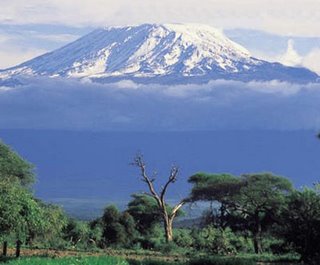A little info about the mountain

Rising 19,340 ft high, snow capped and wreathed in veils of clouds, stands
Mt. Kilimanjaro, the highest mountain in Africa and one of the largest free standing mountains in the world.

Kilimanjaro has three extinct volcanoes:
Kibo (19,340 ft.)
Mawenzi (17,000 ft.)
Shira (13,000 ft.).
Views of the surrounding landscape are spectacular from all the three peaks. The East African Rift valley is visible from Kibo, the highest of the three peaks of the majestic Mt. Kilimanjaro.
Scaling Mt. Kilimanjaro takes you through five distinct clmates that are appoximately 3,300 ft. apart. Each climate varies in rainfall, temperature, flora, and fauna.
A brief description of each follows, while a picture chart of the more common species of flower can be found at the end of the blog.
Cultivated zone and forest (800m - 280m)
The forest zone, along with the cultivated zone that lies below it, together receive the most rainfall - about 2300mm per year - of any part of the mountain. Enormous camphorwoods flourish at this altitude, as do fig, and around Marangu Gate, the grey-barked podocarpus. Hanging from the trees you will find pink and white Begonias that fill the area with thier sweet smell. On the dier northern and western slopes juniper and olive trees proliferate. The star of this zone is the Impatiens kilimanjari, an endemic, it is red and yellow and in the shape of an inch long tuba.
Heath and moorland (2800m - 4000m)
These two zones overlap, and together occupy the area immediately above the forest from around 2800m to 4000m - also known as the low alpine zone.
Temperatures can drop below zero degrees celcius at this altitude, and most of the precipitation that does fall here comes from the fog and mist that are almost permanent fixtures at this height. Immediately above the forest zone is the alpine heath. Rainfall here is around 1300mm per year. Erica's grow in abundance. Climbing higher, grasses beging dominate the mountain slopes with only a few smaller species of protea add colour. Near the top of this zone, you'll begin to come across sedges and start to notice that the shrubs are shrinking in size.
Alpine desert (4000m-5000m)
By the time you reach the saddle, only three species of tussock grass and few everlastings can withstand the extreme conditions. In the alpine desert plants have to survive in drought conditions (precipitation here is less than 200mm per year), and put up with both inordinate cold and intense sun, usually in the same day. One little daisy the Asteraceae manages to bloom up to about 4700m.
Ice cap (5000m-5895m)
On Kibo, almost nothing lives. There is virtually no water. A few mossess and lichens are said to exist all the way to the summit. While these lichen may not be the most spectacular of plants, it may interest you to know that their growth rate on the upper reaches of Kilimanjaro is estimated to be just 0.5mm in diameter per year.
 |  |  |  |
You can reach the summit via five different routes through the five vegetation zones.

 Proudly South African
Proudly South African
0 Comments:
Post a Comment
<< Home